Gigabyte

Gigabyte has a lot of experience in the silent graphics market, and we have several ATI and NVIDIA cards from them for this review. An interesting statistic is that 90% of Gigabyte's shipped graphics solutions are silent, which makes a statement about the desirability of silent cards. Gigabyte is well represented in this review, having provided us with the highest number of solutions for testing. While their cards may not win any awards for good looks (the gold and turquoise coloring and unique heat sink designs aren't very easy on the eyes), they apparently handle silent operation very well, even at higher-than-stock clock speeds.
On the NVIDIA side, we have the Gigabyte 7600 GT, 7600 GS, 7300 GT, and 7300 GS. The Gigabyte 7600 GS comes shipped with its core overclocked to 450MHz, slightly higher (by 50MHz) than the stock version of this card. The Gigabyte 7300 GT also has a factory overclock of 450MHz core clock as opposed to the standard 350MHz core clock and an 800MHz memory clock verses the standard 667MHz memory clock on the 7300 GT. On the ATI side, we have the Gigabyte X1600 XT, X1600 Pro, X1300 Pro and X1300. All other Gigabyte cards aside from the 7600 GS and 7300 GT are clocked at reference speeds.
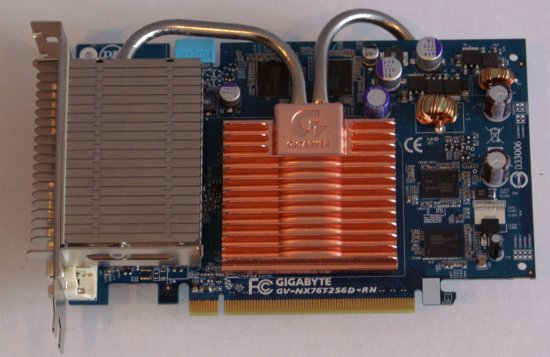
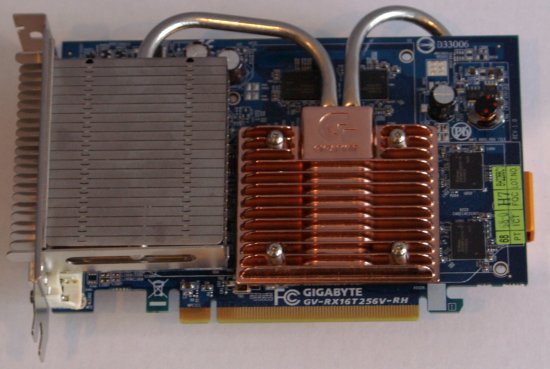
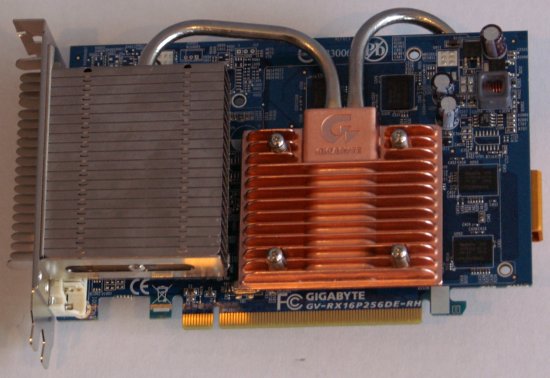
As we can see, the Gigabyte NVIDIA 7600 GT, ATI X1600 XT, and ATI X1600 Pro all have almost identical heat sink designs. The heat sinks are unique, with a bulky sink up front towards the DVI connections and heatpipes connecting to other heat sinks on the front and back of the card. The Gigabyte cards with this style heat sink are much more bulky than the other ones, and it's important to note that the silver heat sink uses up a second slot making these dual-slot solutions.

The Gigabyte X1300 Pro looks almost the same as the previous three Gigabyte cards; however, it is missing the extra heat sink on the back and the second metal pipe that would extend to it. The silver heat sink on the front still takes up an extra slot however, which is a point against this and the other three cards.
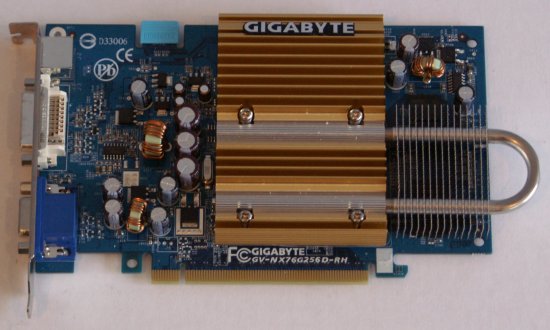
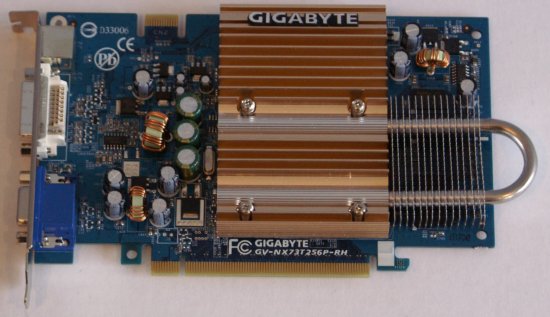
The Gigabyte 7600 GS and 7300 GT are very similar in appearance. The heat sinks on these cards are much more compact than those on the first four cards we mentioned. These cards don't take up an extra slot and only have a gold heat sink on the front, with a strange looking heatpipe running out and back in a "U" shape from the main heat sink. The heatpipe is attached to thin metal sheets, all in the name of increasing surface area and removing heat from the hotter portions of the card. These thin metal sheets seem a little delicate and might bend if the card is mishandled, though a slightly bent heat sink fin isn't really a major problem.
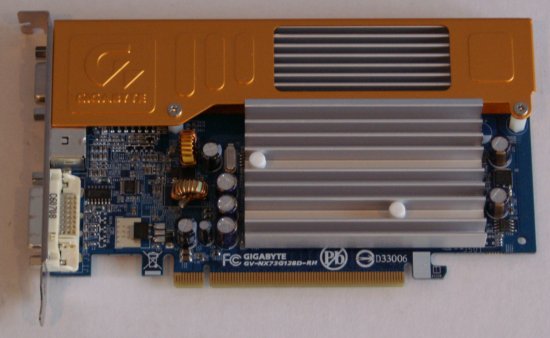
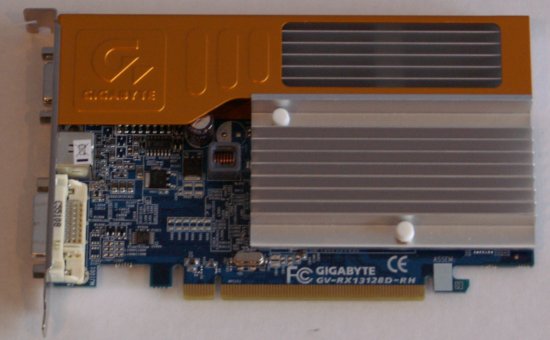
The Gigabyte 7300 GS and X1300 have heat sinks with a unique type of gold cover or hood running along the top part of the cards, over a silver heat sink on the cards' processor. The Gigabyte 7300 GS doesn't have a bridge connector on the top of the card for SLI operation, but it will still run in SLI (with a second card) without the bridge connection.
Gigabyte seems to have a definite plan about their custom heat sink designs, and after testing and overclocking these cards, there isn't much doubt that they perform well. They did, however, tend to get very hot to the touch after repeated testing, to the point where they became difficult to hold. We'll talk more about how well these cards overclocked in the "Overclocking" section.

Gigabyte has a lot of experience in the silent graphics market, and we have several ATI and NVIDIA cards from them for this review. An interesting statistic is that 90% of Gigabyte's shipped graphics solutions are silent, which makes a statement about the desirability of silent cards. Gigabyte is well represented in this review, having provided us with the highest number of solutions for testing. While their cards may not win any awards for good looks (the gold and turquoise coloring and unique heat sink designs aren't very easy on the eyes), they apparently handle silent operation very well, even at higher-than-stock clock speeds.
On the NVIDIA side, we have the Gigabyte 7600 GT, 7600 GS, 7300 GT, and 7300 GS. The Gigabyte 7600 GS comes shipped with its core overclocked to 450MHz, slightly higher (by 50MHz) than the stock version of this card. The Gigabyte 7300 GT also has a factory overclock of 450MHz core clock as opposed to the standard 350MHz core clock and an 800MHz memory clock verses the standard 667MHz memory clock on the 7300 GT. On the ATI side, we have the Gigabyte X1600 XT, X1600 Pro, X1300 Pro and X1300. All other Gigabyte cards aside from the 7600 GS and 7300 GT are clocked at reference speeds.



As we can see, the Gigabyte NVIDIA 7600 GT, ATI X1600 XT, and ATI X1600 Pro all have almost identical heat sink designs. The heat sinks are unique, with a bulky sink up front towards the DVI connections and heatpipes connecting to other heat sinks on the front and back of the card. The Gigabyte cards with this style heat sink are much more bulky than the other ones, and it's important to note that the silver heat sink uses up a second slot making these dual-slot solutions.

The Gigabyte X1300 Pro looks almost the same as the previous three Gigabyte cards; however, it is missing the extra heat sink on the back and the second metal pipe that would extend to it. The silver heat sink on the front still takes up an extra slot however, which is a point against this and the other three cards.


The Gigabyte 7600 GS and 7300 GT are very similar in appearance. The heat sinks on these cards are much more compact than those on the first four cards we mentioned. These cards don't take up an extra slot and only have a gold heat sink on the front, with a strange looking heatpipe running out and back in a "U" shape from the main heat sink. The heatpipe is attached to thin metal sheets, all in the name of increasing surface area and removing heat from the hotter portions of the card. These thin metal sheets seem a little delicate and might bend if the card is mishandled, though a slightly bent heat sink fin isn't really a major problem.


The Gigabyte 7300 GS and X1300 have heat sinks with a unique type of gold cover or hood running along the top part of the cards, over a silver heat sink on the cards' processor. The Gigabyte 7300 GS doesn't have a bridge connector on the top of the card for SLI operation, but it will still run in SLI (with a second card) without the bridge connection.
Gigabyte seems to have a definite plan about their custom heat sink designs, and after testing and overclocking these cards, there isn't much doubt that they perform well. They did, however, tend to get very hot to the touch after repeated testing, to the point where they became difficult to hold. We'll talk more about how well these cards overclocked in the "Overclocking" section.










49 Comments
View All Comments
TheInternal - Tuesday, September 12, 2006 - link
It's wonderful to see Anandtech take the time to review silent products. I've really been trying to quiet down my PC, and seeing this review gave me some further encouragement. With rumors of ASUS acquiring XFX, it will be interesting to see if Anandtech decides to review the passively colled XFX 7950 GT with heat pipes that look awfully reminescent of the ones from the ASUS 7800 you reviewed.I'm also curious to see if any 7900 GS cards become available with passive cooling soon.
Richey02hg - Tuesday, September 5, 2006 - link
I was just curious if any of these cards are AGP? or they all PCI Express only? and also, its hard to tell since an x800xt all in one wonder isnt in there. But would any of these be an upgrade over that? Because I have to admit, just seeing that word "silent" makes me happy cause my GPU is insanely loudJarredWalton - Wednesday, September 6, 2006 - link
All are PCIe. I'm not sure if there are any silent AGP cards out there other than very low end components. As for the X800 XT, that is roughly equivalent to the 7800 GS in performance, albeit without SM 3.0 support. 7600 GT would also be pretty similar in performance I think. I would recommend holding onto your current system as long as you can, and when he can no longer stand the performance it offers do a wholesale upgrade to PCI-E GPU and motherboard, and probably a new CPU and RAM is well. At that point, you might as well just go ahead and buy a completely new system -- you could even try selling off your current system to recoup some of the cost.Richey02hg - Thursday, September 7, 2006 - link
thanks for the advice, Im actually planning to get a laptop in 2006 and thanks to your review im definetly waiting for that second wave (forget the name) of the core 2 duos for laptops :)Eddie Lin - Thursday, August 31, 2006 - link
Gigabyte seems don't need reserve SLI bridge seems 7300GS only go with S/W SLI and don't need bridge. Is really good heatsink design on this cardDerekWilson - Friday, September 1, 2006 - link
Thanks Eddie --We have added this information to the article.
yacoub - Thursday, August 31, 2006 - link
It's an absolute joke that Asus and Gigabyte don't have silently-cooled 7900GTs out yet. The card requires less power and runs cooler than the 7800GT did. It's a shoe-in to get a silent version. wtf.This is practically a roundup of grandfathers and retirees when you include a 7800GT. ;P
nullpointerus - Friday, September 1, 2006 - link
Maybe they are trying to get rid of old cards without dropping the price too much?yyrkoon - Thursday, August 31, 2006 - link
Alot of people that would consider buying a fanless GPU wouldnt even care if it DID make tons of noise, some of us live in deserts, where its extremely dusty. There is nothing like owning an air compressor or two, just for 'dusting' you house, shops, and PC / electronics innards.I guess I'm one of the few people who actually enjoy having a fan or two on while I'm sleeping for background noise, but less moving parts means longer part life here in the Nevada desert. However, I own a eVGA 7600GT KO, that has a fan on it, and you know what, I have a really hard time hearing it from 6 feet away. In fact, the 120mm low RPM fans that came with my Lian Li case make more noise, and they dont make much noise themselves.
I think its a great idea that these manufactuers are making products like this, but at the same time, for me personally its not really an option. I only buy parts from a compnay with a good reputation, and offer excellent customer support, and hence I'm very picky about who I buy from. At the same time, I know what I want, and if something passive isnt availible on say a 7600GT (which is what I wanted for this current system), and at the same time, from a company I would normally buy parts from, then I wont bother. I would think it a better option to buy the part you wanted for a video card, then buy an aftermarket passive cooler if it comes down to that (which would probably void your warranty, so again, for some of us, not really an option).
So basicly, what it boils down to, is that I have to buy a graphics card with a fan to get what I want, and if problems later ensue, its a good thing I have a can of miracle oil around, and a few saringes . . .
Josh Venning - Thursday, August 31, 2006 - link
These are some good points; it's true that with less moving parts you would theoretically see longer life and resistence to dust and dirt, something that could be a plus. And while it's true that a normal graphics card (with a fan on it) will be pretty hard to hear from a little ways away inside your computer case, the idea is that some people need that extra bit of silence for whatever reason, and every extra fan adds to the noise level on the system. For myself, when recording sound/music with a computer, getting things as quiet as possible is very important, so this is one case where eliminating even a couple of dbs is worth buying a silent gpu for. (especially if, like myself, your recording computer is one you also want to be able to play games on.)